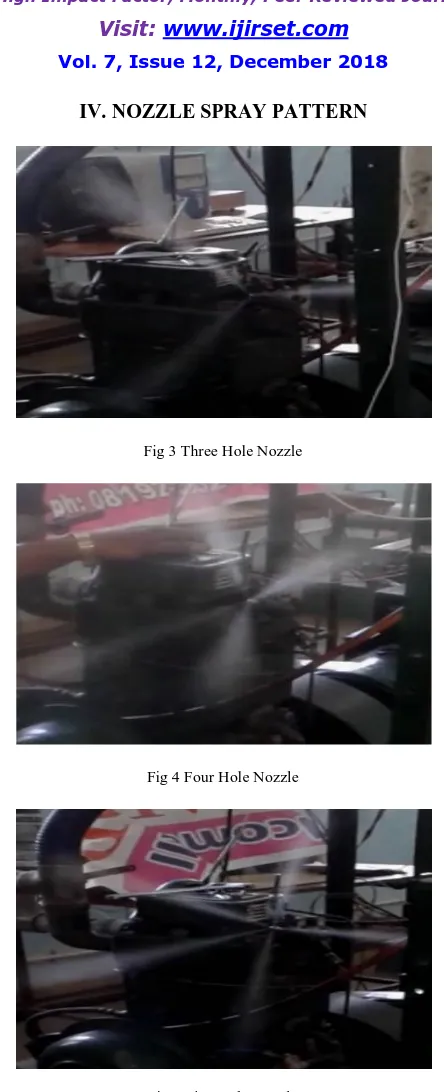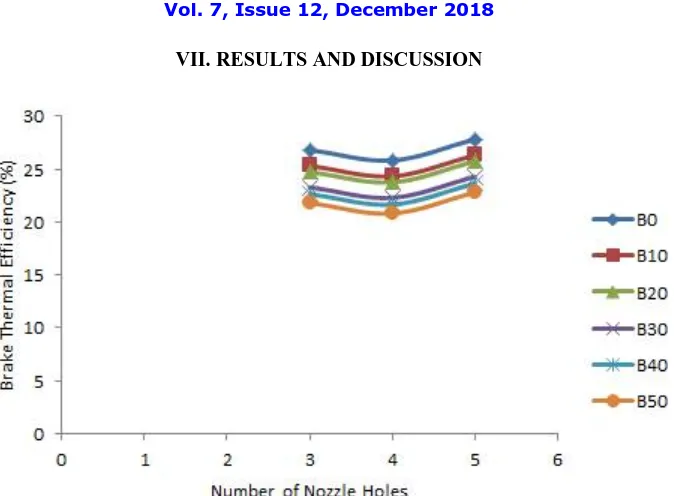Effect of Nozzle Hole Geometry on
Compression Ignition Engine Fuelled with
Thevetia Peruviana Biodiesel
A.J.Deokar1, P.A.Harari2, S.E.Sutar3, P.P.Hodage4, J.V.Patil5, A.R.Kole6
Assistant Professor, Department of Mechanical Engineering, SGMCOE, Mahagaon, India1,2
B.E Final Year Students, Department of Mechanical Engineering, SGMCOE, Mahagaon, India3,4,5,6
ABSTRACT: In the present study an experimental work had been carried out to analyze the performance and emission characteristics of various blends of thevetia peruviana biodiesel by varying nozzle hole diameter. The engine tests are conducted on kirloskar, 4-stroke, single cylinder, 1500 rpm, water cooled, direct injection, diesel engine with eddy current dynamometer with standard injection pressure 230 bar and injection timing 26°BTDC was maintained constant throughout the experiment. 3 different nozzles such as (3×0.28mm), (4×0.23mm), (5×0.20mm) varied to analyze the combustion parameters. From the test results, it could be observed that among 3 different nozzles 5 hole nozzle gives higher efficiency and lower emissions as compared to 4 hole nozzle and 3 hole nozzle.
KEYWORDS: Blends, Compression Ignition, Emission, Nozzle, Performance.
I. INTRODUCTION
tend to increase. CO emissions were found to be lower for decreasing injector hole sizes as the wall impingement with diesel was less compared to that with larger hole size. However higher hole size injectors leads to deposition of fuel on the combustion chamber walls. Hence higher CO emissions were found to be more with larger size hole injector. Increasing the number of holes in the injector resulted in decreased HC. That could be attributed to improved mixing of liquid fuel and the surrounding air inside the combustion chamber with a larger size hole injector and hence resulting in complete combustion. NOx emissions increases with the increase in the number of injector holes due to faster combustion and higher temperatures reached in the cycle. The reason for increased NOx with increased size of holes could be due to better combustion prevailing inside the engine cylinder and more heat released during premixed combustion. Decreased hole size ensures improved air-fuel mixing which results in enhanced combustion that results in reduced smoke opacity levels [9]. For 3 hole nozzle, maximum BTE was found to be 24.32% for diesel, 26.82% for B20 fuel and minimum BSFC was found to be 0.352 kg/kW-hr for diesel, 0.328 kg/kW-hr for B20 fuel at 3.52 kW of BP and at 230 bar injection pressure. For 4 hole nozzle, maximum BTE was found to be 13.54% for diesel, 14.64% for B20 fuel and minimum BSFC was found to be 0.632 kg/kW-hr for diesel, 0.601 kg/kW-hr for B20 fuel at 2.94 kW of BP and at 230 bar injection pressure. For 5 hole nozzle, maximum BTE was found to be 21.28% for diesel, 22.69% for B20 fuel and minimum BSFC was found to be 0.402 kg/kW-hr for diesel, 0.388 kg/kW-hr for B20 fuel at 3.52 kW of BP and at 230 bar injection pressure [10].
II. TRANSESTERIFICATION REACTION
Fig 1 Three mouth flask
Fig 2 Separation of glycerin and biodiesel
III. PROPERTIES OF FUELS
Table 1 Properties of fuels
Property B0 B10 B20 B30 B40 B50
Density (kg/m3) 829 835 839 841 843 846
Viscosity at 40°C (CSt)
3.52 3.76 3.96 4.09 4.22 4.71
Flash Point (°C) 53 68 77 81 83 87
Fire Point (°C) 59 75 86 89 92 95
Calorific Value (MJ/kg)
IV. NOZZLE SPRAY PATTERN
Fig 3 Three Hole Nozzle
Fig 4 Four Hole Nozzle
V. EXPERIMENTAL SETUP
A single cylinder, direct injection, four-stroke, water cooled, Compression Ignition (CI) engine is used in the experimental study. The fuel flow rate was measured by noting down the time taken for the consumption of a known quantity of fuel (10cc) from a burette. The viscosity of raw as well as esterified oil was measured by red wood viscometer, density by hydrometer, calorific value by bomb calorimeter, flash and fire point by open cup method. Initially, before starting experimental tests, the engine was made to run under ideal condition as warm up phase and then the tests were conducted. The engine was started and allowed to warm-up for about 10 minutes. The engine was tested under five discrete part load conditions i.e. 20%, 40%, 60%, 80% and 100%.
Fig 6 Experimental Setup
1-Diesel engine, 2-Burette for fuel measurement, 3-Base, 4-Dynamometer, 5-Coupling, 6-Air supply line, 8-Exhaust gas analyzer, 9-Control panel.
VI. ENGINE PARAMETERS
Table 2 Engine parameters
Engine Parameter Specifications
Engine Type Kirloskar
No. of Strokes 4
No. of Cylinders 1
Type of Cooling Water Cooling
Type of Injection Direct Injection
Bore 87.5 mm
Stroke 110 mm
Compression Ratio 17.5:1
Rated Power 5.2 kW
Rated Speed 1500 rpm
Injection Pressure 230 bar
VII. RESULTS AND DISCUSSION
Fig 7 Variation of Brake Thermal Efficiency with Number of Nozzle Holes
Fig 7 shows variation of brake thermal efficiency with number of nozzle holes. Among all the blends tested B0 blend gives higher brake thermal efficiency because of higher calorific value of the B0 blend. Among different nozzles tested 5 hole nozzle gives the higher brake thermal efficiency because diameter of nozzle holes decreases so that area of nozzle holes also decreases. This results into lower fuel consumption and higher thermal efficiency. For 4 hole nozzle the brake thermal efficiency decreases because the spray pattern of 4 hole nozzle was irregular so that maximum amount of fuel was impinged on the cylinder wall and hence brake thermal efficiency decreased.
Fig 8 shows variation of brake specific fuel consumption with number of nozzle holes. Among all the blends tested B0 blend gives lower brake specific fuel consumption because of higher calorific value of the B0 blend. Among different nozzles tested 5 hole nozzle gives the lower brake specific fuel consumption because diameter of nozzle holes decreases so that area of nozzle holes also decreases. This results into lower fuel consumption and higher thermal efficiency. For 4 hole nozzle the brake specific fuel consumption increases because the spray pattern of 4 hole nozzle was irregular so that maximum amount of fuel was impinged on the cylinder wall and hence brake specific fuel consumption increased.
Fig 9 Variation of Total Fuel Consumption with Number of Nozzle Holes
Fig 10 Variation of Hydrocarbon Emissions with Number of Nozzle Holes
Fig 10 shows variation of hydrocarbon emission with number of nozzle holes. Among all the blends tested B0 blend gives lower hydrocarbon emission because of higher calorific value of the B0 blend. Among different nozzles tested 5 hole nozzle gives the lower hydrocarbon emission because diameter of nozzle holes decreases so that area of nozzle holes also decreases. This results into fuel consumption and higher thermal efficiency and also lower hydrocarbon emission. For 4 hole nozzle the hydrocarbon emission increases because the spray pattern of 4 hole nozzle was irregular so that maximum amount of fuel was impinged on the cylinder wall and hence hydrocarbon emission increased.
Fig 11 Variation of Carbon Monoxide Emissions with Number of Nozzle Holes
that area of nozzle holes also decreases. This results into fuel consumption and higher thermal efficiency and also lower carbon monoxide emission. For 4 hole nozzle the carbon monoxide emission increases because the spray pattern of 4 hole nozzle was irregular so that maximum amount of fuel was impinged on the cylinder wall and hence carbon monoxide emission increased.
Fig 12 Variation of Nitrogen Oxide Emissions with Number of Nozzle Holes
Fig 12 shows variation of nitrogen oxide emission with number of nozzle holes. Among all the blends tested B0 blend gives higher nitrogen oxide emission because of higher calorific value of the B0 blend. Among different nozzles tested 5 hole nozzle gives the higher nitrogen oxide emission because diameter of nozzle holes decreases so that area of nozzle holes also decreases. This results into fuel consumption and higher thermal efficiency and also higher nitrogen oxide emission. For 4 hole nozzle the nitrogen oxide emission decreases because the spray pattern of 4 hole nozzle was irregular so that maximum amount of fuel was impinged on the cylinder wall and hence nitrogen oxide emission decreased.
VIII. CONCLUSION
The brake thermal efficiency of biodiesel blends was found to be lower compared to diesel at all power output. Brake specific fuel consumption for blends of biodiesel blends is higher when compared with diesel. Total fuel consumption for diesel is less as compared to biodiesel blends. Hydrocarbon and carbon monoxide emissions for diesel are lower as compared to biodiesel blends. Nitrogen oxide emissions are higher for diesel as compared to biodiesel blends. Among the biodiesel blends tested, B10 and B20 gave the best performance with reduced emissions. Hence B10 and B20 blends are recommended for existing diesel engine. At all injection nozzles tested 5 hole injection nozzle gives higher brake thermal efficiency, lower brake specific fuel consumption, lower hydrocarbon and carbon monoxide emissions and higher nitrogen oxide emissions. Hence 5 hole injection nozzle is recommended for existing diesel engine.
REFERENCES
1. C.Sayin, M.Gumus, M.Canakci, “Influence of injector hole number on the performance and emissions of a DI diesel engine fueled with biodiesel-diesel fuel blends”, Applied Thermal Engineering 61 (2013) 121-128.
2. R.Sharma, R.R.Singh, S.K.Vishwakarma, “Experimental study of the effect of fuel injector nozzle holes on direct injection diesel engine”, IOSR Journal of Mechanical and Civil Engineering, Volume-7, Issue-4, Pages 67-74, 2013.
4. R.S.Kumar, “Experimental investigation of injectors nozzle hole on CI engine using jatropha oil as biofuel”, International Journal of Scientific Research Engineering & Technology, Volume-3, Issue-8, Pages 1209-1215, 2014.
5. R.L.Swamy, T.K.Chandrashekar, N.R.Banapurmath, P.Nashipudi, “Effect of injection timing, combustion chamber shapes and nozzle geometry on the diesel engine performance”, Universal Journal of Petroleum Sciences 2 (2014), 74-95.
6. S.V.Khandal, N.R.Banapurmath, V.N.Gaitonde, R.S.Hosmath, “Effect of number of injector nozzle holes on the performance, emission and combustion characteristics of honge oil biodiesel (HOME) operated DI compression ignition engine”, Journal of Petroleum and Environmental Biotechnology 2015, 6:3.
7. P.A.Harari, D.S.Akshatha, G.Manavendra, “Effect of Injection Pressure and Nozzle Hole Diameter on Combustion Parameters of CI Engine Fuelled with B20 Neem Blend”, International Journal of Innovative Research in Science, Engineering and Technology, 2015, 4(5), 2857-2870. 8. P.A.Harari, G.Manavendra, “Experimental Investigation on the Combustion Parameters of B20 Neem Blend in CI Engine by Varying Injection
Timing and Nozzle Hole Diameter”, International Journal of Advanced Research and Innovative Ideas in Education, 2015, 1(4), 503-510. 9. P.A.Harari, J.S.Patil, “A Review on Effect of Nozzle Hole Geometry on the Performance, Combustion and Emission Parameters of CI Engine
Fuelled with Diesel and Biodiesel”, International Journal of Engineering and Management Research, 2016, 6(3), 39-48.






